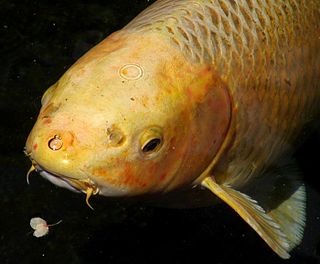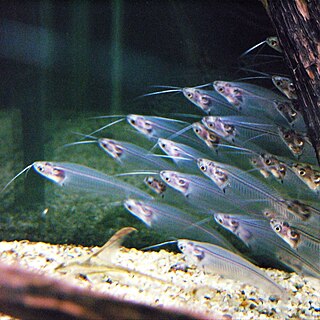| Arius | |
|---|---|
 | |
| Arius arius | |
| Scientific classification | |
| Kingdom: | Animalia |
| Phylum: | Chordata |
| Class: | Actinopterygii |
| Order: | Siluriformes |
| Family: | Ariidae |
| Subfamily: | Ariinae |
| Genus: | Arius Valenciennes in G. Cuvier & Valenciennes, 1840 |
| Type species | |
| Pimelodus arius Hamilton, 1822 | |
| Species | |
See text | |
| Synonyms | |
Arius is a genus of catfishes (order Siluriformes) of the family Ariidae. The genus Arius is distributed in brackish and fresh waters of Eastern Africa and south to Southeast Asia. [2]
A genus is a taxonomic rank used in the biological classification of living and fossil organisms, as well as viruses, in biology. In the hierarchy of biological classification, genus comes above species and below family. In binomial nomenclature, the genus name forms the first part of the binomial species name for each species within the genus.

Catfish are a diverse group of ray-finned fish. Named for their prominent barbels, which resemble a cat's whiskers, catfish range in size and behavior from the three largest species alive, the Mekong giant catfish from Southeast Asia, the wels catfish of Eurasia and the piraíba of South America, to detritivores, and even to a tiny parasitic species commonly called the candiru, Vandellia cirrhosa. There are armour-plated types and there are also naked types, neither having scales. Despite their name, not all catfish have prominent barbels. Members of the Siluriformes order are defined by features of the skull and swimbladder. Catfish are of considerable commercial importance; many of the larger species are farmed or fished for food. Many of the smaller species, particularly the genus Corydoras, are important in the aquarium hobby. Many catfish are nocturnal, but others are crepuscular or diurnal.
In biological classification, the order is
- a taxonomic rank used in the classification of organisms and recognized by the nomenclature codes. Other well-known ranks are life, domain, kingdom, phylum, class, family, genus, and species, with order fitting in between class and family. An immediately higher rank, superorder, may be added directly above order, while suborder would be a lower rank.
- a taxonomic unit, a taxon, in that rank. In that case the plural is orders.
Defining the limits so that Arius can form a natural grouping has always been a problem. The genus was never properly defined, and many species previously classified in Arius are now in other genera. Recent authors have recognized this genus as nonmonophyetic, rejecting that the genus is a natural grouping. Two unnamed groups are distinguished by accessory tooth plates, which are either very elongated and bearing molar-like teeth, or are oval shaped or subtriangular and bearing acicular (needle-like) or conic teeth. [2] A. jatius lacks these tooth plates, but has been included in this genus based on its adipose fin and lateral line. [2] The recognition of Arenarius as a junior synonym of Arius is tentative and needs to be further investigated. [2]

In cladistics, a monophyletic group, or clade, is a group of organisms that consists of all the descendants of a common ancestor. Monophyletic groups are typically characterised by shared derived characteristics (synapomorphies), which distinguish organisms in the clade from other organisms. The arrangement of the members of a monophyletic group is called a monophyly.

The lateral line, also called lateral line system (LLS) or lateral line organ (LLO), is a system of sense organs found in aquatic vertebrates, used to detect movement, vibration, and pressure gradients in the surrounding water. The sensory ability is achieved via modified epithelial cells, known as hair cells, which respond to displacement caused by motion and transduce these signals into electrical impulses via excitatory synapses. Lateral lines serve an important role in schooling behavior, predation, and orientation. Fish can use their lateral line system to follow the vortices produced by fleeing prey. Lateral lines are usually visible as faint lines of pores running lengthwise down each side, from the vicinity of the gill covers to the base of the tail. In some species, the receptive organs of the lateral line have been modified to function as electroreceptors, which are organs used to detect electrical impulses, and as such, these systems remain closely linked. Most amphibian larvae and some fully aquatic adult amphibians possess mechanosensitive systems comparable to the lateral line.
In scientific nomenclature, a synonym is a scientific name that applies to a taxon that (now) goes by a different scientific name, although the term is used somewhat differently in the zoological code of nomenclature. For example, Linnaeus was the first to give a scientific name to the Norway spruce, which he called Pinus abies. This name is no longer in use: it is now a synonym of the current scientific name, Picea abies.
Arius species have three pairs of barbels, including the fleshy and cylindrical maxillary barbels and two pairs of mental barbels. The base of the adipose fin is moderately long, about half the length of the base of the anal fin. [2]

In fish anatomy and turtle anatomy, a barbel is a slender, whiskerlike sensory organ near the mouth. Fish that have barbels include the catfish, the carp, the goatfish, the hagfish, the sturgeon, the zebrafish, the black dragonfish and some species of shark such as the sawshark. Barbels house the taste buds of such fish and are used to search for food in murky water.


















